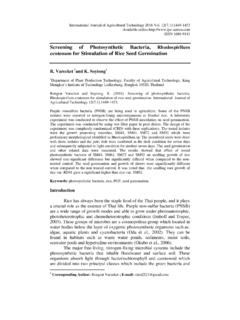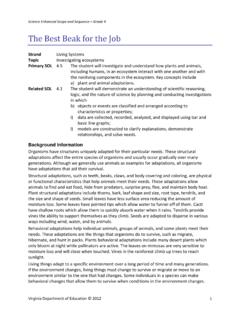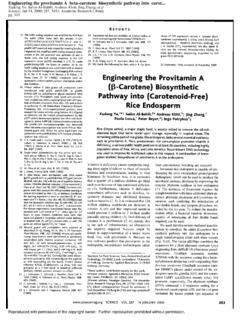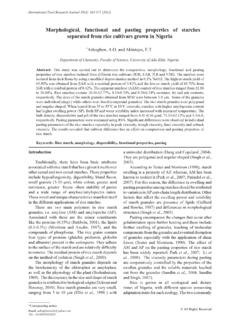Transcription of Nutritional composition of rice bran submitted to ...
1 *Correspondence: S. A. S. Concei o Faria. Departamento de Alimentos e Nutri o Experimental, Faculdade de Ci ncias Farmac uticas, Universidade de S o Paulo. Av. Prof. Lineu Prestes, 580, B13A, 05508-900 - S o Paulo-SP, Brasil. E-mail: Journal of Pharmaceutical Sciencesvol. 48, n. 4, , 2012 Nutritional composition of rice bran submitted to different stabilization proceduresSimone Aparecida dos Santos Concei o Faria1,*, Priscila Zaczuk Bassinello2, Marilene de Vuono Camargo Penteado1,1 Department of Food and Experimental Nutrition, Faculty of Pharmaceutical sciences , University of S o Paulo, 2 EMBRAPA rice and Beans Research CenterIn order to inactivate enzymatic deterioration, whole rice bran samples were subjected to two stabilization methods.
2 Changes in Nutritional value in terms of, concerning chemical composition , minerals and fatty acid content, were evaluated to supplement existing data and promote the utilization of rice bran in the human diet. The following homemade heat treatments were applied: roasting on a conventional stove or heating in a microwave oven. Based on the results, the different heating methods affected sample composition , since the levels of some nutrients of treated samples showed significant changes (p< ) compared to corresponding raw samples. The rice bran treated on a conventional stove produced products with lower moisture ( g/100 g) and nutrients such as sodium ; palmitic acid and stearic acid The microwave oven procedure resulted in better nutrient preservation, with slightly higher moisture content ( g/100 g), and appears to be a practical and rapid tool for home heat stabilization of rice : rice bran/ Nutritional composition .
3 rice bran/ Nutritional value. rice bran/heat treatment. Oryza sativa/phytochemistry. Human diet. Fatty acids/in food. Minerals/in food. Enzymatic fim de inativar a deteriora o enzim tica, as amostras de farelo de arroz foram submetidas a dois m todos de estabiliza o. As mudan as do valor nutricional, no que se refere a composi o qu mica, os minerais e o conte do de cidos graxos, foram avaliadas para adicionar mais informa es aos dados existentes e promover a utiliza o de farelo de arroz na dieta humana. Os seguintes tratamentos caseiros por calor foram aplicados: torra em forno convencional ou de aquecimento em forno de micro-ondas. Com base nos resultados, os diferentes m todos de aquecimento afetaram a composi o das amostras, j que os n veis de alguns nutrientes mostraram altera es significativas (p <0,05), comparado com as amostras cruas correspondentes.
4 O farelo de arroz tratado em fog o convencional forneceu produtos com menos umidade (5,14 0,10 g/100 g) e nutrientes, tais como: de s dio 11,8%; cido palm tico 9,9% e cido este rico 8,1%. O procedimento de forno de micro-ondas resultou em melhor preserva o dos nutrientes, com teor de umidade um pouco maior (6,28 0,10 g/100 g), o que parece ser uma ferramenta pr tica e r pida no tratamento t rmico caseiro para o farelo de : Farelo de arroz/composi o nutricional. Farelo de arroz/valor nutricional Farelo de arroz/tratamento t rmico. Oryza sativa/fitoqu mica. Dieta humana. Tratamento t rmico. cidos graxos/em alimentos. Minerais/em alimentos. Inativa o enzim bran is a by-product of the rice (Oryza sativa L.)
5 Processing industry. In India and other countries, approximately one million tons of bran are produced an-nually and used predominantly for animal feed (Zhongli et al., 2005; Sumantha et al., 2006). Recently, the use of rice bran is gaining importance in many studies due to the fact that, during the processing of whole rice , large amounts of the grain s outer layers are removed, raising the concentration of nutrients in the bran and rendering it an important source of nutrients for the food industry S. A. S. C. Faria, P. Z. Bassinello, M. V. C. Penteado652and human consumption (Xu, Godber, 1999; Carvalho, Bassinello, 2006; Parrado et al., 2006; Renuka, Arumu-ghan, 2007; Imsanguan et al., 2008; Lilitchan et al.)
6 , 2008). However, its utilization is limited due to enzymatic activity after rice dehulling. rice bran is rich in lipids and intense lipase activity in the presence of endogenous lipoxygenase causes rapid deterioration of these lipids by rancification (Paucar-Menacho et al., 2007). Because of lipid suscepti-bility, the commercial use of rice bran requires enzymatic inactivation immediately after bran separation to avoid fatty acid liberation, extend its shelf life and allow its commercialization for human consumption (Wada, 2001). Enzymatic inactivation can be achieved by heating to high temperatures for a short period (Ramezanzadeh et al., 1999). Some industries extrude the defatted rice bran for use mainly as animal feed.
7 In countries such as Brazil, stabilized rice bran for human consumption is not widely available at supermarkets. Consequently, consumers look-ing for the product have to acquire it raw directly from rice processing companies and subject it to heat treatment in a conventional stove or microwave oven. These treat-ments are known as homemade stabilization methods. The rice bran has been introduced into a multi-mixture of toasted flour (generally in home-made form) consist-ing of food industry waste, as part of a Brazilian social program to restore the health of malnourished children (Silva et al., 2006). However, little is known about the influence of these processes on the Nutritional value of rice bran.
8 Therefore, this work was conducted to evaluate the effect of two different stabilization procedures on the level of preservation of the Nutritional composition of rice bran, and to provide further information about a potential food ingredient for the human diet. From a commercial perspective, when there is a growing market for rice bran with added value and more scientific information available about its benefits, industries are expected to show more interest in processing the product for human consumption besides its current use as animal AND METHODSThe stabilization treatment defined as homemade (roasting on a conventional stove or heating in a micro-wave oven) was performed using rice bran samples pro-vided by EMBRAPA rice and Beans Research Center, county of Santo Ant nio de Goi s Goi s state, where the upland rice cultivar BRS Primavera was grown at its Capivara Farm.
9 The crop was harvested between April and May 2006, observing the best harvest point at which around 2/3 of the panicle is ripe. Approximately 120 kg of the rice harvested (paddy rice ) was cleaned, purged with phosphine gas to prevent insect infestation, and stored in a room under controlled temperature (25 oC). rice samples were subjected to the standard process to separate bran using a rice mill (Suzuki) at the rice Breeding Program Laboratory. rice bran samples were then prepared for the stabilization treatments and subsequent analyses. Homemade treatmentsRice bran provided by EMBRAPA was divided into three samples: whole rice bran (WRB) or crude (control); microwaved rice bran (MRB) and roasted rice bran (RRB).
10 200 g of MRB was treated in a microwave oven (Samsung 950W) set at level 5 or medium power for 6 minutes (around 78 C) and manually mixed every 2 minutes. The RRB (200 g) was heated on a conventional six-flame stove by filling a pre-heated 20 cm diameter stainless steel pot 2/3 full with sample. In this case, stabilization was per-formed at approximately 80 C (high flame level) for 6 minutes, and samples were homogenized with a wooden spoon throughout the process. The heat treatments were performed in three repetitions and analyses were per-formed in triplicate for each heat treatment, including the untreated control sample. Final results were expressed as means for each collected and prepared samples were kept at room temperature to cool and then sealed in plastic bags (polypropylene) and stored in a freezer at -12 C for less than 24 hours until analyses.















